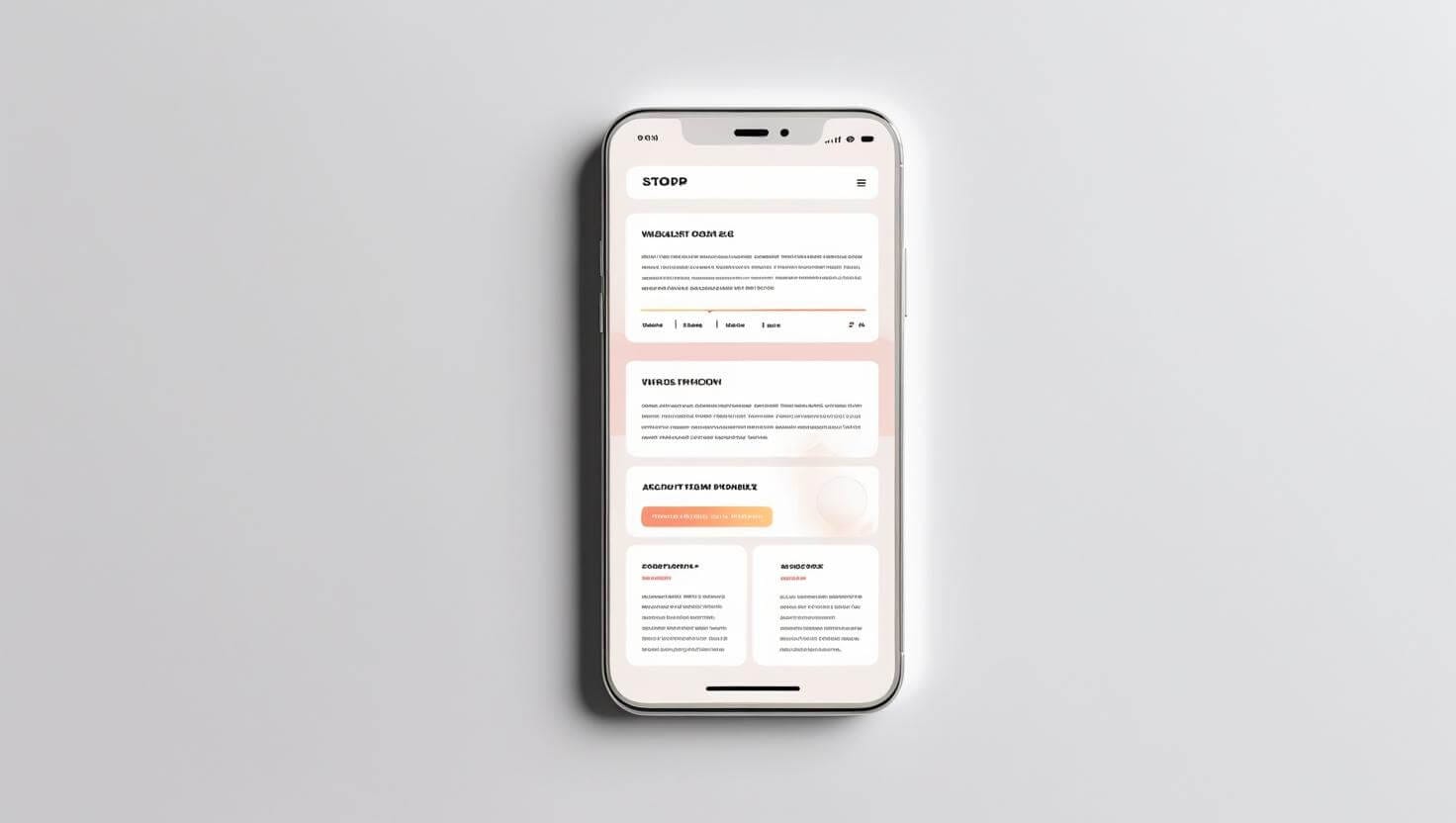Mobile-Friendly Web Design in 2025: Why It’s Critical for Your SEO Success

In 2025, more than half of your visitors browse from a mobile device and Google knows this. Google prioritizes mobile-first design in its indexing. Having a mobile-friendly web design is no longer optional. It’s a must! If your site isn’t optimized for mobile users, you’re not just losing traffic – you’re losing rankings. A mobile-friendly website ensures faster load times, easier navigation, and a seamless user experience on mobile devices. It’s also a core part of responsive web design, which adapts your site layout across all screen sizes.
Mobile web design connects directly with your technical SEO strategy. If you are new to technical SEO is can be useful to read this step-by-step guide about technical SEO.
What Is Mobile-Friendly Web Design?
Mobile-friendly web design means your website works perfectly on any mobile device.
It’s built to provide a smooth, fast, and user-friendly experience for people browsing on phones or tablets. You design with smaller screens in mind, using layouts, fonts, and navigation that feel natural on mobile devices.
This approach isn’t just about shrinking your desktop site. It’s about optimizing every element for mobile use.
A truly mobile-friendly website is part of responsive web design, which automatically adjusts content to fit any screen size. You also want to think about mobile-first design, which starts the design process with mobile users as your top priority.
When your mobile web design is clean and efficient, users stay longer and bounce less. Google notices this and will see it as a sign that your website provides value.
This improved user experience on mobile devices boosts engagement and supports better SEO results.
Why Mobile-Friendly Websites Matter in 2025
In 2025, visitors are impatient. If your site isn’t mobile-friendly, they’ll leave before it even loads.
Mobile-friendly web design ensures your content looks great and functions smoothly on any smartphone or tablet.
Google now evaluates your website’s mobile performance before anything else. A mobile-friendly website directly influences your SEO rankings. It’s not just about visibility, it’s about credibility. Users judge your brand based on how easily they can navigate your mobile site.
A poor mobile web design frustrates users, reduces engagement, and kills conversions. With mobile traffic dominating the web, user experience on mobile devices has become your competitive edge.
How Google Evaluates Mobile Friendliness in 2025
In 2025, as already discussed, Google primarily uses mobile-first indexing. This means Google looks at your mobile website version before anything else. If your mobile site isn’t well-optimized, your rankings will suffer, regardless of how good your desktop site is.
Google evaluates multiple factors when checking mobile friendliness. First, page speed matters. Your site needs to load quickly on mobile devices, or visitors will bounce immediately. Slow loading times are a clear red flag for Google.
Next, Google assesses how your site layout adapts across various screen sizes. That’s where responsive web design comes into play.
Navigation is another crucial point. If users struggle to find what they need, Google interprets this as poor user experience on mobile devices. Mobile usability errors like overlapping elements or small clickable areas can hurt your SEO performance.
Google also considers your site’s content visibility on mobile. If important information is hidden or hard to access on phones, it affects rankings. Sites designed with mobile in mind from the start perform better in search results.
Finally, Google uses real-world user data through the Core Web Vitals metrics. These metrics measure loading performance, interactivity, and visual stability on mobile devices. Improving these will boost your site’s SEO and provide a smoother experience for visitors.
By understanding and applying these mobile-friendly web design standards, you ensure your website meets Google’s expectations.
8 Best Mobile-Friendly Web Design Practices
1. Use a Responsive Design Framework
Responsive web design is the foundation of mobile usability. It ensures your layout adjusts automatically to fit any screen size.
If your site isn’t responsive, it risks being unreadable on smaller screens. This will increase the chances of users leaving.
You want to deliver a consistent experience across all devices without needing a separate mobile site.
Actionable steps you can take now:
- Use frameworks like Bootstrap or Foundation to streamline responsive layout development.
- Set flexible grids and breakpoints to adjust content to different screens.
- Always test how your site looks in both portrait and landscape orientations.
2. Optimize Loading Speed for Mobile Users
Mobile users are impatient. If your page takes more than a few seconds to load, they’ll bounce. Fast-loading pages are not only good for users, they are vital for SEO. Google tracks page speed as part of its Core Web Vitals.
This is especially important for mobile-first design, where data connections might be slower.
Actionable steps you can take now:
- Use lazy loading for images and videos.
- Minify CSS, JavaScript, and HTML files.
- Use a lightweight theme or template built for mobile performance.
- Choose fast, reliable hosting with CDN support.
3. Keep Navigation Simple & Thumb-Friendly
Cluttered navigation ruins the user experience on mobile devices. You need menus that are easy to tap and clearly labeled.
Users primarily interact with their thumbs. Thumb-friendly interfaces reduce friction and make it easier for users to explore your content.
Actionable steps you can take now:
- Use a hamburger menu to simplify navigation on small screens.
- Keep top-level menu items under five.
- Make sure buttons and links are spaced far enough apart.
- Ensure all tappable elements meet Google’s minimum size recommendations (48×48 pixels).
4. Prioritize Readable Fonts & Font Sizes
Your content should be readable without zooming or squinting. Small, hard-to-read text frustrates users and sends a poor signal to Google.
Typography is a key part of any effective mobile web design strategy.
Actionable steps you can take now:
- Use at least 16px for body text on mobile.
- Stick to web-safe, legible fonts like Arial, Roboto, or Open Sans.
- Maintain high contrast between text and background for readability.
- Avoid script or decorative fonts that are hard to read on small screens.
5. Avoid Pop-Ups & Intrusive Interstitials
Google penalizes mobile websites with aggressive pop-ups. Users hate them, and they kill engagement. Even if you’re using them for lead capture or promotions, they must be subtle and easy to dismiss.
Mobile-first design means putting the user first, especially when it comes to interruptions.
Actionable steps you can take now:
- Use slide-ins or banner notifications instead of full-screen pop-ups.
- Delay promotional content until after the user engages with the page.
- Always include a clear and easy close button.
- Test how your pop-ups appear on smaller screens.
6. Use Scalable Images & Compress Media
Large, unoptimized images destroy load times and break layouts on smaller screens. Scalable media adapts to any screen size without losing quality or breaking your design.
A mobile-friendly website uses images smartly to support content, not slow it down.
Actionable steps you can take now:
- Use responsive image formats (like WebP or AVIF) that scale based on screen size.
- Compress all images using tools like TinyPNG or Squoosh.
- Set max-width to 100% in CSS to make images responsive.
- Avoid autoplay videos on mobile unless they’re muted and lightweight.
7. Design with Touch in Mind (No Tiny Buttons)
Don’t design for mouse clicks. Design for fingers. Your mobile-friendly web design must anticipate how users interact via touch.
Tiny buttons or links make users work too hard and that will also increase the likelihood of them bouncing early.
Actionable steps you can take now:
- Make all buttons and links large enough to tap without zooming.
- Leave enough space between interactive elements.
- Avoid hover-based interactions—they don’t work well on mobile.
- Prioritize gesture-friendly design for better usability.
8. Test Across Multiple Devices & Screen Sizes
You can’t assume your site works on all devices just because it looks good on your iPhone. Every device has different screen sizes, resolutions, and behaviors.
A truly mobile-friendly website performs consistently across all platforms.
Actionable steps you can take now:
- Use tools like BrowserStack or Responsively App to preview your site across multiple devices.
- Manually test on both Android and iOS if possible.
- Check tablet compatibility, not just smartphones.
- Validate your design with Google’s Mobile-Friendly Test and PageSpeed Insights.
3 Tools to Check If Your Website Is Mobile-Friendly
1. PageSpeed Insights
Mobile usability isn’t just about design. It’s also about performance. PageSpeed Insights helps you measure how fast your mobile site loads and how stable it feels during use.
Just add your URL and press analyze. It evaluates both mobile and desktop versions. It gives you a performance score and shows detailed Core Web Vitals data.
Why you should use it:
- Measures loading speed, interactivity, and visual stability on mobile.
- Shows lab and field data based on real users.
- Gives practical suggestions like image compression and code minification.
- Helps boost mobile-first SEO by improving user experience on mobile devices.
2. BrowserStack Responsive Design Checker
A mobile-friendly website must work across multiple screen sizes and devices, not just one.
BrowserStack’s Responsive Design Checker lets you preview how your site looks and functions on dozens of mobile devices, right in your browser. It’s ideal for spotting layout breaks, font issues, or elements that behave differently across screens.
Why you should use it:
- Real-time previews across popular smartphones and tablets.
- No setup needed—just enter your URL and select a device.
- Shows how your responsive web design adapts to real-world viewports.
- Great for spotting device-specific bugs in navigation, spacing, and fonts.
This tool gives you visual confirmation that your mobile-first design actually works as intended everywhere.
3. Lighthouse (via Chrome DevTools)
Lighthouse is a powerful tool built into Chrome DevTools that helps you evaluate your website’s mobile usability alongside performance, SEO, and accessibility.
Its mobile usability audit highlights issues like tap targets that are too small, viewport configuration problems, and content wider than the screen.
Here is how to access Lighthouse via Chrome DevTools:
Step 1: Click the three dots in the right top corner of your screen, click on more tools and click on developer tools.
Step 2: Click on the Lighthouse Tool.
Step 3: Click on Analyze page load.
The report will show some moments later with all the necessary information.
Why you should use it:
Runs directly in your browser with no installation needed.
Provides detailed, actionable reports on mobile UX issues.
Combines mobile usability with performance and SEO insights.
Helps prioritize fixes that improve both user experience and search rankings.
Lighthouse gives you a comprehensive overview of how well your site performs on mobile devices and where to focus your optimization efforts.
3 Tools To Improve Your Mobile Web Design
1. Figma
Figma is a cloud-based design tool that helps you create responsive layouts visually. You can design your entire mobile-friendly website interface in Figma before writing a single line of HTML. It’s perfect for mobile-first design because it lets you build layouts specifically for small screens first, then scale up.
Advantages of Figma:
- Design responsive web pages with flexible layout grids
- Preview and test mobile-friendly website mockups in real time
- Use pre-built mobile UI kits to speed up design
- Collaborate with clients or teams without versioning issues
- Easily switch between mobile and desktop breakpoints
If you’re aiming for a user-centered mobile web experience, Figma helps you think mobile from the very beginning.
2. Webflow
Webflow bridges the gap between design and development. It’s a visual website builder that produces clean, production-ready code. You can create a responsive web design by dragging, dropping, and styling elements with pixel-level control.
Webflow ensures your site is mobile-optimized and lightweight. It also automatically generates responsive layouts using CSS Grid and Flexbox.
Advantages of Webflow:
- Build mobile-friendly websites without writing code
- Export SEO-ready, responsive HTML/CSS
- Control layout across all screen sizes with visual breakpoints
- Host directly or export your code for full control
- Integrated CMS and animations enhance mobile UX
If you want full control over how your mobile web design performs and looks, Webflow is an all-in-one solution.
3. Polypane
Polypane is a browser built specifically for testing and improving responsive web design. It allows you to view your site on multiple screen sizes side-by-side, all in real-time.
Polypane gives a true picture of how your site behaves on different devices. You’ll instantly spot design inconsistencies, layout issues, and performance flaws.
Advantages of Polypane:
- Simulate multiple screen sizes in a single browser view
- Spot and fix layout shifts before they affect user experience
- Built-in audits for performance, SEO, and accessibility
- Live reloading saves time during testing
- Pinpoint UX issues that hurt mobile-first SEO
Polypane gives you granular control over every detail of your design.


